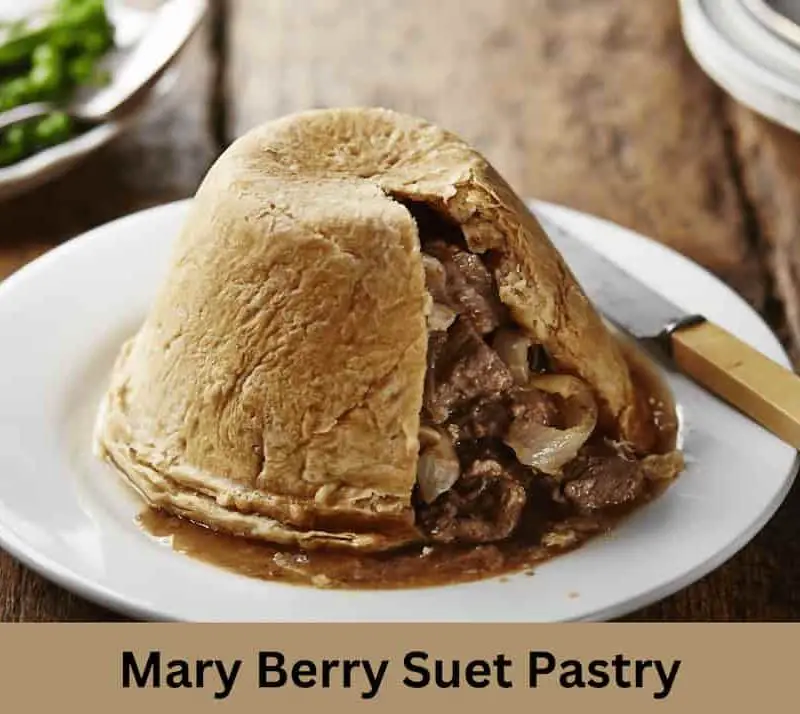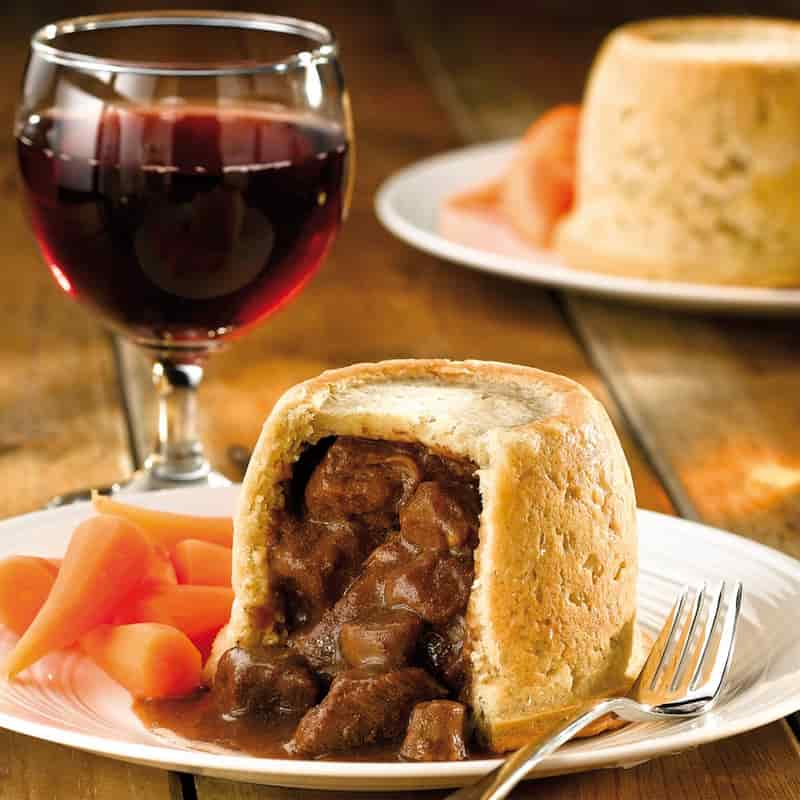
Suet pastry is a type of pastry that is made with suet, which is the hard fat around the kidneys and loins of animals, usually beef or mutton. Suet pastry is rich, flaky, and tender, and it is perfect for making pies, puddings, and dumplings.
In this article, I will show you how to make suet pastry using Mary Berry’s recipe, which is one of the best and easiest recipes I have ever tried. Mary Berry is a famous British baker, cookbook author, and television personality, who is known for her expertise and elegance in baking. She has been making suet pastry for decades, and she has shared her tips and tricks for making it successfully.
Why You Love this Recipe
- It is easy, simple, and delicious
- It only requires four ingredients: flour, suet, salt, and water
- It can be used to make various dishes, such as pies, puddings, and dumplings
- It is light and airy, with a buttery flavor and texture
- It is versatile and can be customized with different fillings and toppings
- It is a classic and timeless recipe that will comfort and satisfy you
What is Mary Berry Suet Pastry?
Mary Berry suet pastry is a type of pastry that is made with suet, which is the hard fat around the kidneys and loins of animals, usually beef or mutton. Suet pastry is rich, flaky, and tender, and it is perfect for making pies, puddings, and dumplings.
What You Need to Make Suet Pastry
To make suet pastry, you will need the following ingredients:
- 250 g (9 oz) self-raising flour. This is the base of the pastry, and it will help it rise and become light and airy. You can also use plain flour and add 2 teaspoons of baking powder to it.
- 125 g (4.5 oz) shredded suet. This is the fat that will give the pastry its richness and flakiness.
- A pinch of salt. This will enhance the flavor of the pastry and balance the sweetness of the suet.
- 150 ml (5 fl oz) cold water. This will bind the ingredients together and form a smooth and pliable dough. You may need more or less water depending on the humidity and the type of flour you use, so add it gradually and adjust as needed.
How to Make Suet Pastry
To make suet pastry, follow these simple steps:
- Sift the flour and salt into a large mixing bowl. This will aerate the flour and remove any lumps or impurities. You can also use a whisk to fluff up the flour and salt.
- Add the suet and mix well with a fork or your fingertips. You want to distribute the suet evenly throughout the flour but do not overmix or rub it in too much. You should still see some small pieces of suet in the mixture, which will create pockets of air and steam in the pastry and make it flaky.
- Make a well in the center of the mixture and gradually add the water, stirring with a knife or a spatula. You want to bring the mixture together into a soft and slightly sticky dough, but not too wet or sticky. You may not need all the water, or you may need a little more, depending on the consistency of your dough. If it is too dry, add more water, one tablespoon at a time. If it is too wet, add more flour, one tablespoon at a time.
- Turn the dough out onto a lightly floured surface and knead it gently for a few seconds. You do not want to overwork the dough, as this will make it tough and dense. You just want to smooth it out and shape it into a ball.
- Wrap the dough in cling film and chill it in the refrigerator for at least 30 minutes. This will allow the gluten in the flour to relax and the suet to firm up, which will make the pastry easier to roll out and more tender and flaky.
How to Use Suet Pastry
You can use suet pastry to make various dishes, such as pies, puddings, and dumplings. Here are some examples of how to use suet pastry:
To make a pie.
- Roll out dough into a circle slightly larger than a pie dish
- Fill a pie dish with the desired filling
- Seal the dough circle over filling by pressing the edges
- Cut a steam vent in the center
- Brush with egg wash and bake until golden brown
To make a pudding.
- Roll out dough and cut a circle to line the basin
- Grease the basin and fit the dough circle inside
- Fill with desired filling and seal dough overhang
- Steam pudding in boiling water for 1.5-2 hours
- Turn out pudding and serve with custard or cream
To make dumplings.
- Divide dough into 8 equal pieces
- Shape each piece into a ball
- Place on a baking tray and refrigerate for 15 minutes
- Add balls to simmering stew or soup
- Make sure partially submerged in liquid
- Cover and cook for 20-25 minutes
- Serve hot with stew or soup
What Do I Serve With Mary Berry Suet Pastry?
Depending on the dish, you can serve it with different sauces and accompaniments, such as:
- Gravy, mashed potatoes, and green beans for a meat pie
- Custard, cream, or ice cream for a jam pudding
- Tomato sauce, salad, or bread for cheese dumplings
- You can also serve some fresh fruit, wine, or tea to balance the richness and sweetness of the pastry

How do I store Mary Berry Suet Pastry Leftovers?
- Store them in an airtight container in the refrigerator for up to 3 days, or in the freezer for up to 3 months
- Let the pastry cool completely before storing it, and label the container with the date and the contents
- Wrap the pastry in some cling film or foil to prevent it from drying out or getting soggy
How do I reheat Mary Berry Suet Pastry Leftovers?
Reheat them in the oven, microwave, or on the stovetop, depending on the dish, as follows:
- For oven reheating, preheat the oven to 180°C (160°C fan, gas mark 4) and place the pastry in a baking dish. Cover the dish with some foil and bake for 15 to 20 minutes, or until the pastry is hot and crisp
- For microwave reheating, place the pastry in a microwave-safe dish and cover it with some damp paper towels. Microwave for 2 to 3 minutes, or until the pastry is hot and soft
- For stovetop reheating, place the pastry in a saucepan and add some water or broth. Bring the mixture to a boil and then simmer for 10 to 15 minutes, or until the pastry is hot and moist
Tips and Tricks for Making the Perfect Suet Pastry
Here are some tips and tricks for making suet pastry successfully:
- Use cold water and cold suet. This will prevent the suet from melting too quickly and make the pastry flakier and lighter.
- Do not overmix or overwork the dough. This will develop the gluten in the flour and make the pastry tough and dense. You want to keep the dough as soft and tender as possible.
- Chill the dough before using it. This will relax the gluten in the flour and firm up the suet, which will make the pastry easier to roll out and more tender and flaky.
- Adjust the amount of water and flour as needed. The amount of water and flour you need may vary depending on the humidity and the type of flour and suet you use. You want the dough to be soft and slightly sticky, but not too wet or sticky. You can always add more water or flour, one tablespoon at a time, to achieve the right consistency.
- Use a sharp knife or a pastry cutter to cut the dough. This will prevent the dough from sticking to the surface and the rolling pin, and also create clean edges for the pastry, which will help it rise and seal better.
Variations of Mary Berry Suet Pastry
- Add fresh herbs like chopped parsley, thyme, rosemary, or oregano for a savory flavor
- Include dried herbs like basil, tarragon, or marjoram for a floral aroma
- Add spices like cinnamon, nutmeg, ginger, or allspice for warmth and sweetness
- Fold in grated hard cheeses like Parmesan, cheddar, or Pecorino for richness
- Include crumbled blue cheese like Gorgonzola or Roquefort for tang
- Add dried fruits like raisins, currants, cranberries, or chopped apricots for sweetness
- Fold in nuts like walnuts, almonds, or pistachios for crunch
- Swirl in nut or seed butter like peanut or almond butter for texture
- Add lemon or orange zest for citrus flavor and aroma
- Use different fats like lard or vegetable shortening instead of suet
- Replace some flour with oats, breadcrumbs, or ground nuts
- Add a pinch of salt to enhance overall flavors
- Brush pastry with egg wash or milk for golden browning
- Chill dough before rolling for easy handling
FAQs
What is the difference between suet pastry and shortcrust pastry?
Suet pastry and shortcrust pastry are two types of pastry that are used for different purposes. Suet pastry is made with suet, which is the hard fat around the kidneys and loins of animals, usually beef or mutton. Suet pastry is rich, flaky, and tender, and it is perfect for making pies, puddings, and dumplings. Shortcrust pastry is made with butter or margarine, and it is more crumbly and delicate, and it is ideal for making tarts, quiches, and pastries.
Can I use vegetarian suet instead of animal suet?
Yes, you can use vegetarian suet instead of animal suet to make suet pastry. Vegetarian suet is made from vegetable oil and wheat flour, and it has a similar texture and flavor to animal suet. You can use the same amount of vegetarian suet as animal suet in the recipe, and follow the same steps to make the pastry.
How do I make Mary Berry suet pastry gluten-free?
To make Mary Berry suet pastry gluten-free, you can use gluten-free self-raising flour instead of regular self-raising flour. You can also add a teaspoon of xanthan gum to the flour to help the pastry bind better and become more elastic. You can use either gluten-free animal suet or gluten-free vegetarian suet to make the pastry.
Final Words
Suet pastry is a delicious and versatile type of pastry that is easy to make with Mary Berry’s recipe. You can use suet pastry to make pies, puddings, and dumplings, and enjoy them with your family and friends. Suet pastry is rich, flaky, and tender, and it will make your dishes more satisfying and comforting. I hope you enjoyed this article and learned how to make suet pastry with Mary Berry’s recipe. If you have any questions or comments, please feel free to leave them below. Happy baking!

